MG414: Organisational Behaviour - Culture and Motivation Report
VerifiedAdded on 2022/12/26
|11
|3245
|357
Report
AI Summary
This report delves into the realm of organisational behaviour, focusing on the significance of organisational culture and its impact on employee motivation and overall effectiveness. It begins by introducing the Edgar Schein model for organisational culture, exploring how culture is developed and how it enhances organisational effectiveness, particularly in communication. The report then examines the role of culture in motivating employees, highlighting models such as Maslow's hierarchy of needs. The second section provides a case study of Unilever, analysing its organisational culture through the lens of Schein's model, including artefacts, values, and assumptions. It investigates Unilever's communication strategies to improve its organisational culture and how the company motivates its employees. The report concludes by summarizing key findings and suggesting ways to enhance organisational culture within the context of Unilever and more broadly.
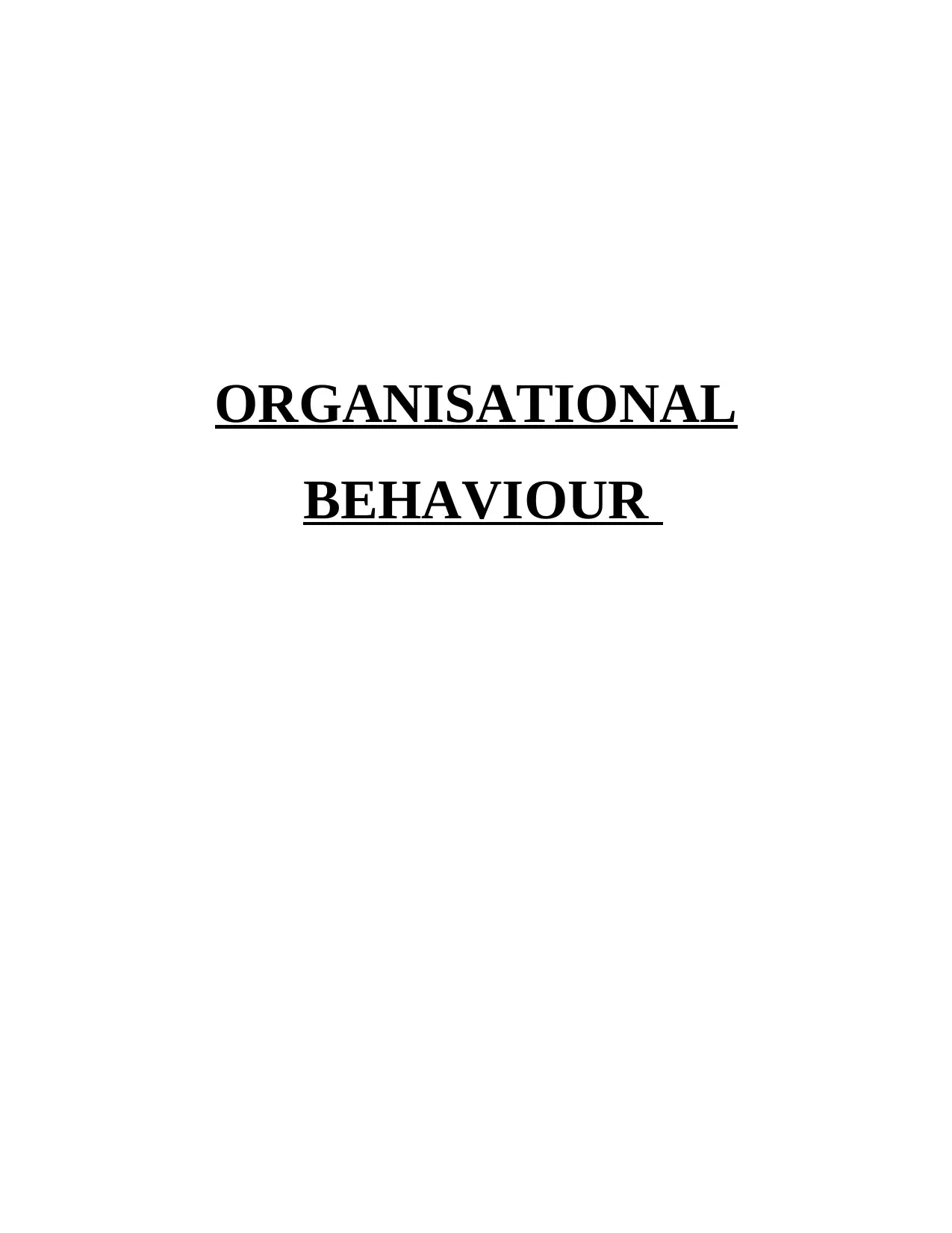
ORGANISATIONAL
BEHAVIOUR
BEHAVIOUR
Paraphrase This Document
Need a fresh take? Get an instant paraphrase of this document with our AI Paraphraser
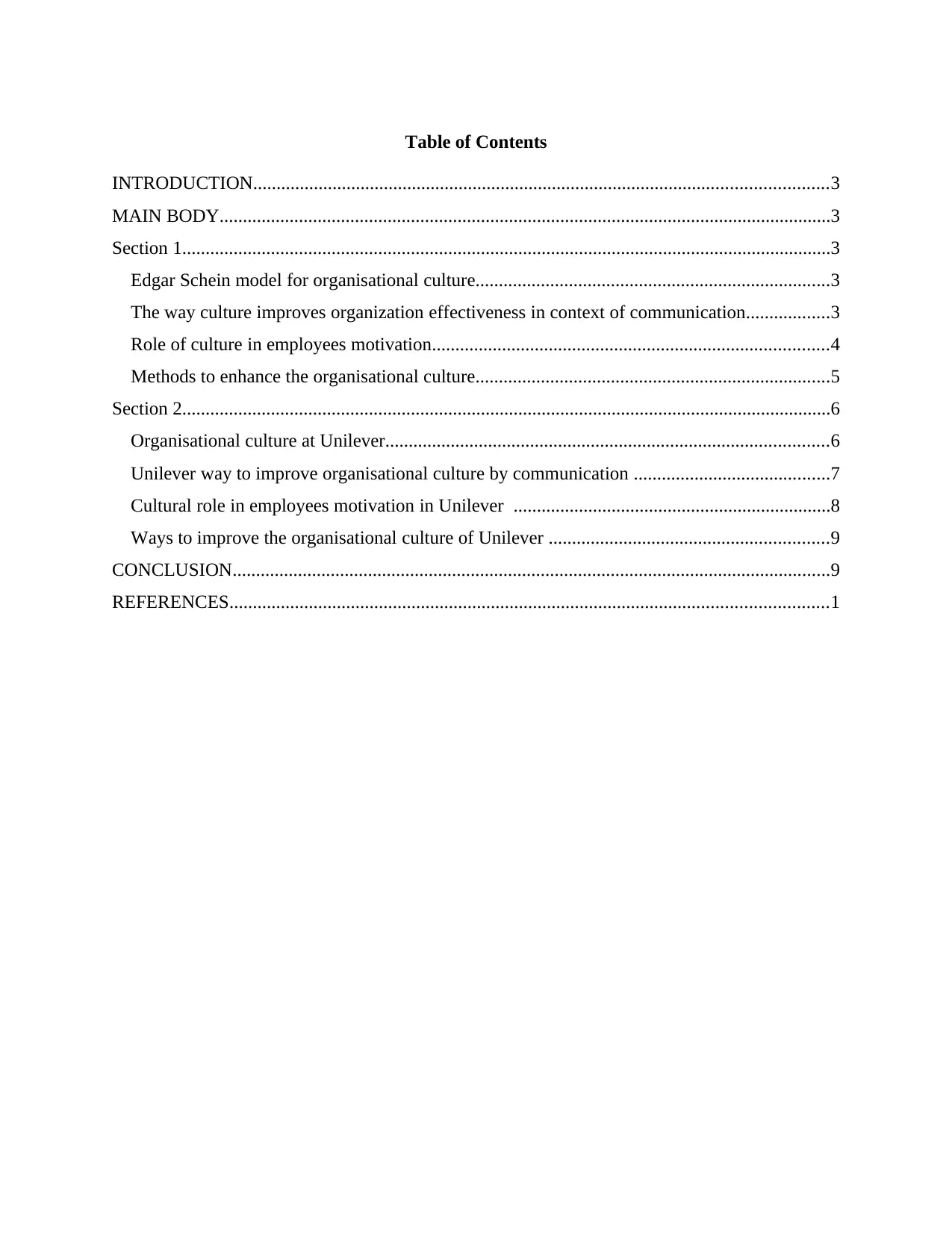
Table of Contents
INTRODUCTION...........................................................................................................................3
MAIN BODY...................................................................................................................................3
Section 1...........................................................................................................................................3
Edgar Schein model for organisational culture............................................................................3
The way culture improves organization effectiveness in context of communication..................3
Role of culture in employees motivation.....................................................................................4
Methods to enhance the organisational culture............................................................................5
Section 2...........................................................................................................................................6
Organisational culture at Unilever...............................................................................................6
Unilever way to improve organisational culture by communication ..........................................7
Cultural role in employees motivation in Unilever ....................................................................8
Ways to improve the organisational culture of Unilever ............................................................9
CONCLUSION................................................................................................................................9
REFERENCES................................................................................................................................1
INTRODUCTION...........................................................................................................................3
MAIN BODY...................................................................................................................................3
Section 1...........................................................................................................................................3
Edgar Schein model for organisational culture............................................................................3
The way culture improves organization effectiveness in context of communication..................3
Role of culture in employees motivation.....................................................................................4
Methods to enhance the organisational culture............................................................................5
Section 2...........................................................................................................................................6
Organisational culture at Unilever...............................................................................................6
Unilever way to improve organisational culture by communication ..........................................7
Cultural role in employees motivation in Unilever ....................................................................8
Ways to improve the organisational culture of Unilever ............................................................9
CONCLUSION................................................................................................................................9
REFERENCES................................................................................................................................1
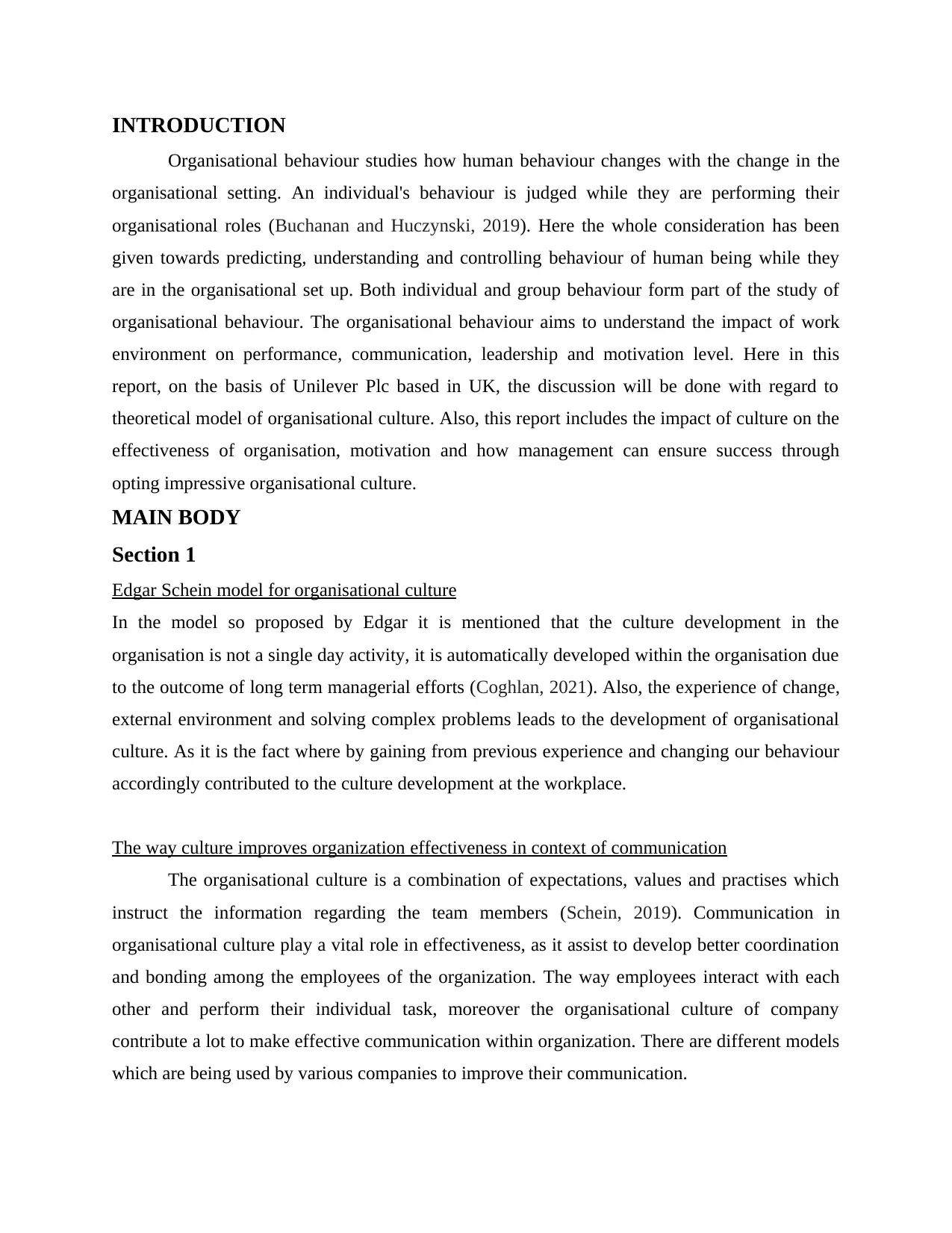
INTRODUCTION
Organisational behaviour studies how human behaviour changes with the change in the
organisational setting. An individual's behaviour is judged while they are performing their
organisational roles (Buchanan and Huczynski, 2019). Here the whole consideration has been
given towards predicting, understanding and controlling behaviour of human being while they
are in the organisational set up. Both individual and group behaviour form part of the study of
organisational behaviour. The organisational behaviour aims to understand the impact of work
environment on performance, communication, leadership and motivation level. Here in this
report, on the basis of Unilever Plc based in UK, the discussion will be done with regard to
theoretical model of organisational culture. Also, this report includes the impact of culture on the
effectiveness of organisation, motivation and how management can ensure success through
opting impressive organisational culture.
MAIN BODY
Section 1
Edgar Schein model for organisational culture
In the model so proposed by Edgar it is mentioned that the culture development in the
organisation is not a single day activity, it is automatically developed within the organisation due
to the outcome of long term managerial efforts (Coghlan, 2021). Also, the experience of change,
external environment and solving complex problems leads to the development of organisational
culture. As it is the fact where by gaining from previous experience and changing our behaviour
accordingly contributed to the culture development at the workplace.
The way culture improves organization effectiveness in context of communication
The organisational culture is a combination of expectations, values and practises which
instruct the information regarding the team members (Schein, 2019). Communication in
organisational culture play a vital role in effectiveness, as it assist to develop better coordination
and bonding among the employees of the organization. The way employees interact with each
other and perform their individual task, moreover the organisational culture of company
contribute a lot to make effective communication within organization. There are different models
which are being used by various companies to improve their communication.
Organisational behaviour studies how human behaviour changes with the change in the
organisational setting. An individual's behaviour is judged while they are performing their
organisational roles (Buchanan and Huczynski, 2019). Here the whole consideration has been
given towards predicting, understanding and controlling behaviour of human being while they
are in the organisational set up. Both individual and group behaviour form part of the study of
organisational behaviour. The organisational behaviour aims to understand the impact of work
environment on performance, communication, leadership and motivation level. Here in this
report, on the basis of Unilever Plc based in UK, the discussion will be done with regard to
theoretical model of organisational culture. Also, this report includes the impact of culture on the
effectiveness of organisation, motivation and how management can ensure success through
opting impressive organisational culture.
MAIN BODY
Section 1
Edgar Schein model for organisational culture
In the model so proposed by Edgar it is mentioned that the culture development in the
organisation is not a single day activity, it is automatically developed within the organisation due
to the outcome of long term managerial efforts (Coghlan, 2021). Also, the experience of change,
external environment and solving complex problems leads to the development of organisational
culture. As it is the fact where by gaining from previous experience and changing our behaviour
accordingly contributed to the culture development at the workplace.
The way culture improves organization effectiveness in context of communication
The organisational culture is a combination of expectations, values and practises which
instruct the information regarding the team members (Schein, 2019). Communication in
organisational culture play a vital role in effectiveness, as it assist to develop better coordination
and bonding among the employees of the organization. The way employees interact with each
other and perform their individual task, moreover the organisational culture of company
contribute a lot to make effective communication within organization. There are different models
which are being used by various companies to improve their communication.
⊘ This is a preview!⊘
Do you want full access?
Subscribe today to unlock all pages.

Trusted by 1+ million students worldwide
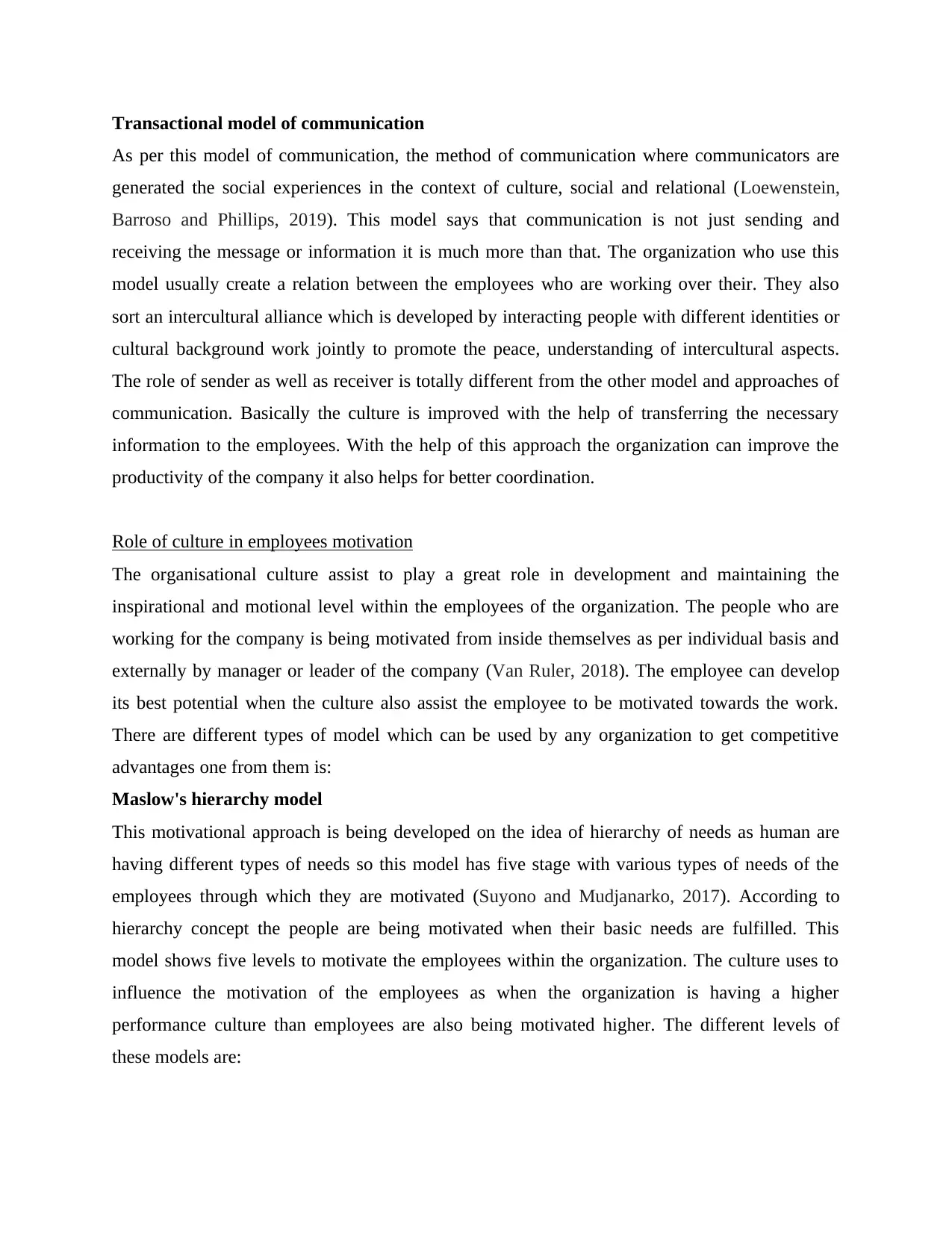
Transactional model of communication
As per this model of communication, the method of communication where communicators are
generated the social experiences in the context of culture, social and relational (Loewenstein,
Barroso and Phillips, 2019). This model says that communication is not just sending and
receiving the message or information it is much more than that. The organization who use this
model usually create a relation between the employees who are working over their. They also
sort an intercultural alliance which is developed by interacting people with different identities or
cultural background work jointly to promote the peace, understanding of intercultural aspects.
The role of sender as well as receiver is totally different from the other model and approaches of
communication. Basically the culture is improved with the help of transferring the necessary
information to the employees. With the help of this approach the organization can improve the
productivity of the company it also helps for better coordination.
Role of culture in employees motivation
The organisational culture assist to play a great role in development and maintaining the
inspirational and motional level within the employees of the organization. The people who are
working for the company is being motivated from inside themselves as per individual basis and
externally by manager or leader of the company (Van Ruler, 2018). The employee can develop
its best potential when the culture also assist the employee to be motivated towards the work.
There are different types of model which can be used by any organization to get competitive
advantages one from them is:
Maslow's hierarchy model
This motivational approach is being developed on the idea of hierarchy of needs as human are
having different types of needs so this model has five stage with various types of needs of the
employees through which they are motivated (Suyono and Mudjanarko, 2017). According to
hierarchy concept the people are being motivated when their basic needs are fulfilled. This
model shows five levels to motivate the employees within the organization. The culture uses to
influence the motivation of the employees as when the organization is having a higher
performance culture than employees are also being motivated higher. The different levels of
these models are:
As per this model of communication, the method of communication where communicators are
generated the social experiences in the context of culture, social and relational (Loewenstein,
Barroso and Phillips, 2019). This model says that communication is not just sending and
receiving the message or information it is much more than that. The organization who use this
model usually create a relation between the employees who are working over their. They also
sort an intercultural alliance which is developed by interacting people with different identities or
cultural background work jointly to promote the peace, understanding of intercultural aspects.
The role of sender as well as receiver is totally different from the other model and approaches of
communication. Basically the culture is improved with the help of transferring the necessary
information to the employees. With the help of this approach the organization can improve the
productivity of the company it also helps for better coordination.
Role of culture in employees motivation
The organisational culture assist to play a great role in development and maintaining the
inspirational and motional level within the employees of the organization. The people who are
working for the company is being motivated from inside themselves as per individual basis and
externally by manager or leader of the company (Van Ruler, 2018). The employee can develop
its best potential when the culture also assist the employee to be motivated towards the work.
There are different types of model which can be used by any organization to get competitive
advantages one from them is:
Maslow's hierarchy model
This motivational approach is being developed on the idea of hierarchy of needs as human are
having different types of needs so this model has five stage with various types of needs of the
employees through which they are motivated (Suyono and Mudjanarko, 2017). According to
hierarchy concept the people are being motivated when their basic needs are fulfilled. This
model shows five levels to motivate the employees within the organization. The culture uses to
influence the motivation of the employees as when the organization is having a higher
performance culture than employees are also being motivated higher. The different levels of
these models are:
Paraphrase This Document
Need a fresh take? Get an instant paraphrase of this document with our AI Paraphraser
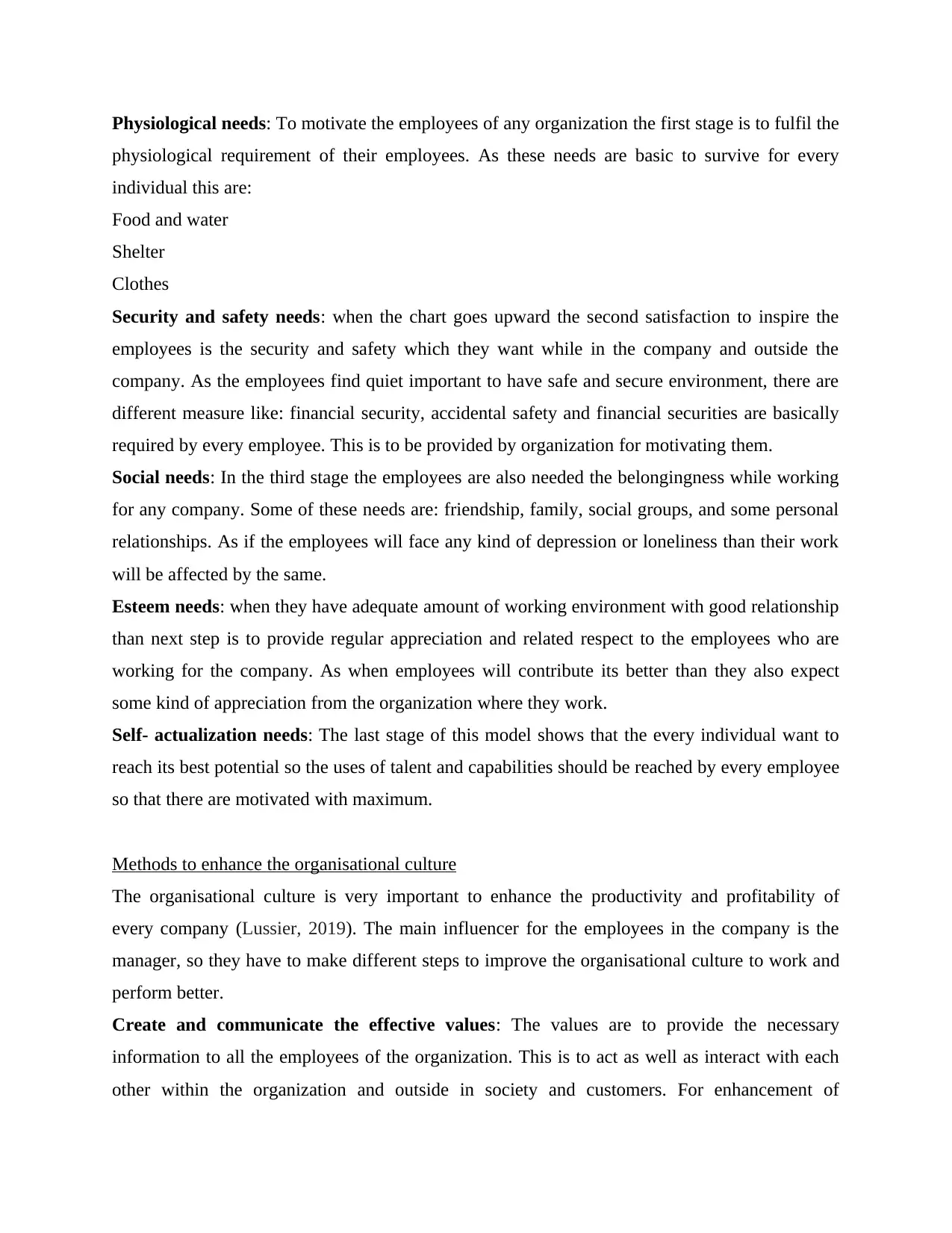
Physiological needs: To motivate the employees of any organization the first stage is to fulfil the
physiological requirement of their employees. As these needs are basic to survive for every
individual this are:
Food and water
Shelter
Clothes
Security and safety needs: when the chart goes upward the second satisfaction to inspire the
employees is the security and safety which they want while in the company and outside the
company. As the employees find quiet important to have safe and secure environment, there are
different measure like: financial security, accidental safety and financial securities are basically
required by every employee. This is to be provided by organization for motivating them.
Social needs: In the third stage the employees are also needed the belongingness while working
for any company. Some of these needs are: friendship, family, social groups, and some personal
relationships. As if the employees will face any kind of depression or loneliness than their work
will be affected by the same.
Esteem needs: when they have adequate amount of working environment with good relationship
than next step is to provide regular appreciation and related respect to the employees who are
working for the company. As when employees will contribute its better than they also expect
some kind of appreciation from the organization where they work.
Self- actualization needs: The last stage of this model shows that the every individual want to
reach its best potential so the uses of talent and capabilities should be reached by every employee
so that there are motivated with maximum.
Methods to enhance the organisational culture
The organisational culture is very important to enhance the productivity and profitability of
every company (Lussier, 2019). The main influencer for the employees in the company is the
manager, so they have to make different steps to improve the organisational culture to work and
perform better.
Create and communicate the effective values: The values are to provide the necessary
information to all the employees of the organization. This is to act as well as interact with each
other within the organization and outside in society and customers. For enhancement of
physiological requirement of their employees. As these needs are basic to survive for every
individual this are:
Food and water
Shelter
Clothes
Security and safety needs: when the chart goes upward the second satisfaction to inspire the
employees is the security and safety which they want while in the company and outside the
company. As the employees find quiet important to have safe and secure environment, there are
different measure like: financial security, accidental safety and financial securities are basically
required by every employee. This is to be provided by organization for motivating them.
Social needs: In the third stage the employees are also needed the belongingness while working
for any company. Some of these needs are: friendship, family, social groups, and some personal
relationships. As if the employees will face any kind of depression or loneliness than their work
will be affected by the same.
Esteem needs: when they have adequate amount of working environment with good relationship
than next step is to provide regular appreciation and related respect to the employees who are
working for the company. As when employees will contribute its better than they also expect
some kind of appreciation from the organization where they work.
Self- actualization needs: The last stage of this model shows that the every individual want to
reach its best potential so the uses of talent and capabilities should be reached by every employee
so that there are motivated with maximum.
Methods to enhance the organisational culture
The organisational culture is very important to enhance the productivity and profitability of
every company (Lussier, 2019). The main influencer for the employees in the company is the
manager, so they have to make different steps to improve the organisational culture to work and
perform better.
Create and communicate the effective values: The values are to provide the necessary
information to all the employees of the organization. This is to act as well as interact with each
other within the organization and outside in society and customers. For enhancement of

organisational culture the leaders of the organization should also communicate the values with
the effective behaviour with its associated with each other.
Enabling and empower the employees: for better cultural environment the managers should
provide essential information to the employees. They should also show the needs of success as it
is important to develop trust in employees.
Section 2
Organisational culture at Unilever
Unilever's mission and vision statements is to the point and brief. This indicates no use of
dialogues and dialects in order to represent their opinion and goals and objectives to the
stakeholders and public at large.
The three levels as per Schein belief in an organisational culture which are as follows:
Artefacts: It indicates the characteristics of the company which can be determined easily through
seen, felt and heard by individuals which is known as artefacts (Velmurugan and Sankar, 2017).
It includes office furnitures, employee's dress code, employee's behaviour within organization,
vision and mission of the company. Visible and tangible factors from the organisational culture
of the Unilever encompasses its artefacts. Examples from the Unilever's artefacts are its office
layout, dress code of its employee and open door policy. The artefacts of Unilever's
organisational culture can be easily viewed but one can't interpret it easily.
Values: It consists of employee's attitude and thought process which have a deep impact over the
culture of every organization. It can be said that values form part of employee's mindset, where it
is important for management to consider what people within organization thinks. Core values of
Unilever includes standards, principles and shared goals. This includes collaboration,
accountability, leadership, passion and integrity within organisation. By effectively
communicating its core values to employees, Unilever has ensured acceptability from employees
and subsequent modification in their behaviour as per the organisational values.
Assumptions: This element of the organisational culture involves assumed values which doesn't
actually made difference to the organisational culture. The hidden facts and beliefs indirectly
affect organisational culture. Assumed values emerges from the inner feelings and emotions of
the employees. Like uncomfortably of female employees in the culture of late sittings in an
organisation, so the culture must be differentiated one where female employees are dominating
the effective behaviour with its associated with each other.
Enabling and empower the employees: for better cultural environment the managers should
provide essential information to the employees. They should also show the needs of success as it
is important to develop trust in employees.
Section 2
Organisational culture at Unilever
Unilever's mission and vision statements is to the point and brief. This indicates no use of
dialogues and dialects in order to represent their opinion and goals and objectives to the
stakeholders and public at large.
The three levels as per Schein belief in an organisational culture which are as follows:
Artefacts: It indicates the characteristics of the company which can be determined easily through
seen, felt and heard by individuals which is known as artefacts (Velmurugan and Sankar, 2017).
It includes office furnitures, employee's dress code, employee's behaviour within organization,
vision and mission of the company. Visible and tangible factors from the organisational culture
of the Unilever encompasses its artefacts. Examples from the Unilever's artefacts are its office
layout, dress code of its employee and open door policy. The artefacts of Unilever's
organisational culture can be easily viewed but one can't interpret it easily.
Values: It consists of employee's attitude and thought process which have a deep impact over the
culture of every organization. It can be said that values form part of employee's mindset, where it
is important for management to consider what people within organization thinks. Core values of
Unilever includes standards, principles and shared goals. This includes collaboration,
accountability, leadership, passion and integrity within organisation. By effectively
communicating its core values to employees, Unilever has ensured acceptability from employees
and subsequent modification in their behaviour as per the organisational values.
Assumptions: This element of the organisational culture involves assumed values which doesn't
actually made difference to the organisational culture. The hidden facts and beliefs indirectly
affect organisational culture. Assumed values emerges from the inner feelings and emotions of
the employees. Like uncomfortably of female employees in the culture of late sittings in an
organisation, so the culture must be differentiated one where female employees are dominating
⊘ This is a preview!⊘
Do you want full access?
Subscribe today to unlock all pages.

Trusted by 1+ million students worldwide
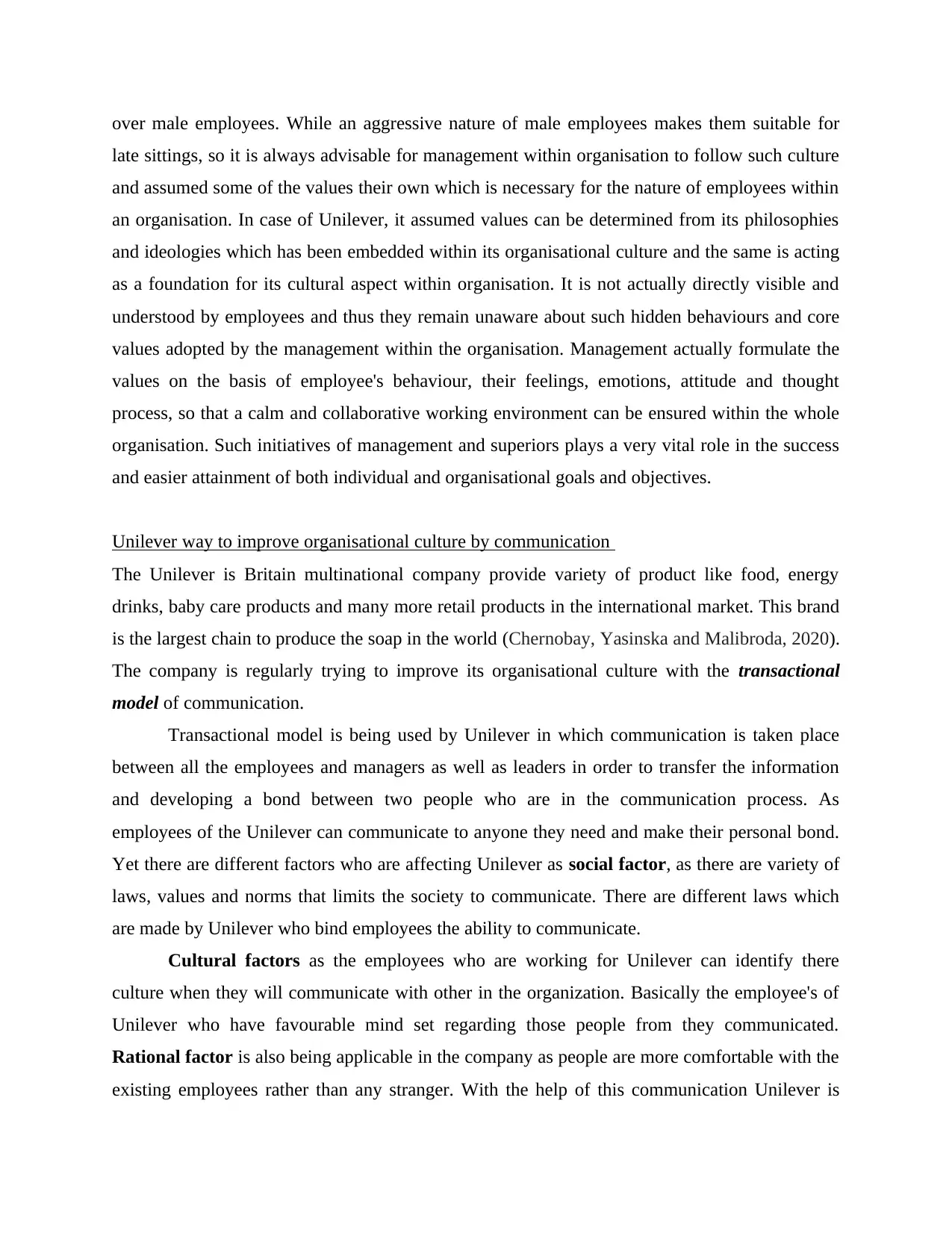
over male employees. While an aggressive nature of male employees makes them suitable for
late sittings, so it is always advisable for management within organisation to follow such culture
and assumed some of the values their own which is necessary for the nature of employees within
an organisation. In case of Unilever, it assumed values can be determined from its philosophies
and ideologies which has been embedded within its organisational culture and the same is acting
as a foundation for its cultural aspect within organisation. It is not actually directly visible and
understood by employees and thus they remain unaware about such hidden behaviours and core
values adopted by the management within the organisation. Management actually formulate the
values on the basis of employee's behaviour, their feelings, emotions, attitude and thought
process, so that a calm and collaborative working environment can be ensured within the whole
organisation. Such initiatives of management and superiors plays a very vital role in the success
and easier attainment of both individual and organisational goals and objectives.
Unilever way to improve organisational culture by communication
The Unilever is Britain multinational company provide variety of product like food, energy
drinks, baby care products and many more retail products in the international market. This brand
is the largest chain to produce the soap in the world (Chernobay, Yasinska and Malibroda, 2020).
The company is regularly trying to improve its organisational culture with the transactional
model of communication.
Transactional model is being used by Unilever in which communication is taken place
between all the employees and managers as well as leaders in order to transfer the information
and developing a bond between two people who are in the communication process. As
employees of the Unilever can communicate to anyone they need and make their personal bond.
Yet there are different factors who are affecting Unilever as social factor, as there are variety of
laws, values and norms that limits the society to communicate. There are different laws which
are made by Unilever who bind employees the ability to communicate.
Cultural factors as the employees who are working for Unilever can identify there
culture when they will communicate with other in the organization. Basically the employee's of
Unilever who have favourable mind set regarding those people from they communicated.
Rational factor is also being applicable in the company as people are more comfortable with the
existing employees rather than any stranger. With the help of this communication Unilever is
late sittings, so it is always advisable for management within organisation to follow such culture
and assumed some of the values their own which is necessary for the nature of employees within
an organisation. In case of Unilever, it assumed values can be determined from its philosophies
and ideologies which has been embedded within its organisational culture and the same is acting
as a foundation for its cultural aspect within organisation. It is not actually directly visible and
understood by employees and thus they remain unaware about such hidden behaviours and core
values adopted by the management within the organisation. Management actually formulate the
values on the basis of employee's behaviour, their feelings, emotions, attitude and thought
process, so that a calm and collaborative working environment can be ensured within the whole
organisation. Such initiatives of management and superiors plays a very vital role in the success
and easier attainment of both individual and organisational goals and objectives.
Unilever way to improve organisational culture by communication
The Unilever is Britain multinational company provide variety of product like food, energy
drinks, baby care products and many more retail products in the international market. This brand
is the largest chain to produce the soap in the world (Chernobay, Yasinska and Malibroda, 2020).
The company is regularly trying to improve its organisational culture with the transactional
model of communication.
Transactional model is being used by Unilever in which communication is taken place
between all the employees and managers as well as leaders in order to transfer the information
and developing a bond between two people who are in the communication process. As
employees of the Unilever can communicate to anyone they need and make their personal bond.
Yet there are different factors who are affecting Unilever as social factor, as there are variety of
laws, values and norms that limits the society to communicate. There are different laws which
are made by Unilever who bind employees the ability to communicate.
Cultural factors as the employees who are working for Unilever can identify there
culture when they will communicate with other in the organization. Basically the employee's of
Unilever who have favourable mind set regarding those people from they communicated.
Rational factor is also being applicable in the company as people are more comfortable with the
existing employees rather than any stranger. With the help of this communication Unilever is
Paraphrase This Document
Need a fresh take? Get an instant paraphrase of this document with our AI Paraphraser

continuously growing in the international market. The employees are working jointly and are
more engaged in the work and all have a positive attitude regarding the work environment and
the work. Employees will also retain for long term within the Unilever with the respective
communication process.
Cultural role in employees motivation in Unilever
The Unilever culture is a performance culture as the business is focussing on various
improvement program as well as products quality is also being addressed (Karim and Fayez,
2020). With the help of leadership and particular employee in the company are also supported.
The managers and leaders of Unilever are using Maslow's hierarchy model to motivate its
employees in effective manner. As per this model the employees of Unilever are being provided
adequate amount of salary so that they are being satisfied with the company regarding the payroll
process. With the help of this they physiological needs are being fulfilled. As the Unilever is a
multinational company so the employees who are working over their need to be safe and secure
as this is another need in the model of Maslow's hierarchy. The company is providing financial
securities to their employees so that they may be less stressed and perform their best in their
work. Providing healthy and secure environment of working so that employees not face issue
while working.
When the employees are not able to motivated with safety than Unilever can also
motivate them by letting them know their importance within the organization (Dundon and
Rafferty, 2018). Offer them such environment where they can make bond with the people who
are working with them. Esteem needs are also required by the employees when they are working
of the Unilever so by providing respect and appreciation the employees get motivated. The
employees usually perform their best, and they want they should be rewarded for them so by
giving regular remuneration and bonus to the employees. For the optimal satisfaction the self
actualization may be required by the employees of the Unilever so by providing opportunity to
reach the maximum potential people of the organization are motivated highly and perform their
best in the work.
more engaged in the work and all have a positive attitude regarding the work environment and
the work. Employees will also retain for long term within the Unilever with the respective
communication process.
Cultural role in employees motivation in Unilever
The Unilever culture is a performance culture as the business is focussing on various
improvement program as well as products quality is also being addressed (Karim and Fayez,
2020). With the help of leadership and particular employee in the company are also supported.
The managers and leaders of Unilever are using Maslow's hierarchy model to motivate its
employees in effective manner. As per this model the employees of Unilever are being provided
adequate amount of salary so that they are being satisfied with the company regarding the payroll
process. With the help of this they physiological needs are being fulfilled. As the Unilever is a
multinational company so the employees who are working over their need to be safe and secure
as this is another need in the model of Maslow's hierarchy. The company is providing financial
securities to their employees so that they may be less stressed and perform their best in their
work. Providing healthy and secure environment of working so that employees not face issue
while working.
When the employees are not able to motivated with safety than Unilever can also
motivate them by letting them know their importance within the organization (Dundon and
Rafferty, 2018). Offer them such environment where they can make bond with the people who
are working with them. Esteem needs are also required by the employees when they are working
of the Unilever so by providing respect and appreciation the employees get motivated. The
employees usually perform their best, and they want they should be rewarded for them so by
giving regular remuneration and bonus to the employees. For the optimal satisfaction the self
actualization may be required by the employees of the Unilever so by providing opportunity to
reach the maximum potential people of the organization are motivated highly and perform their
best in the work.
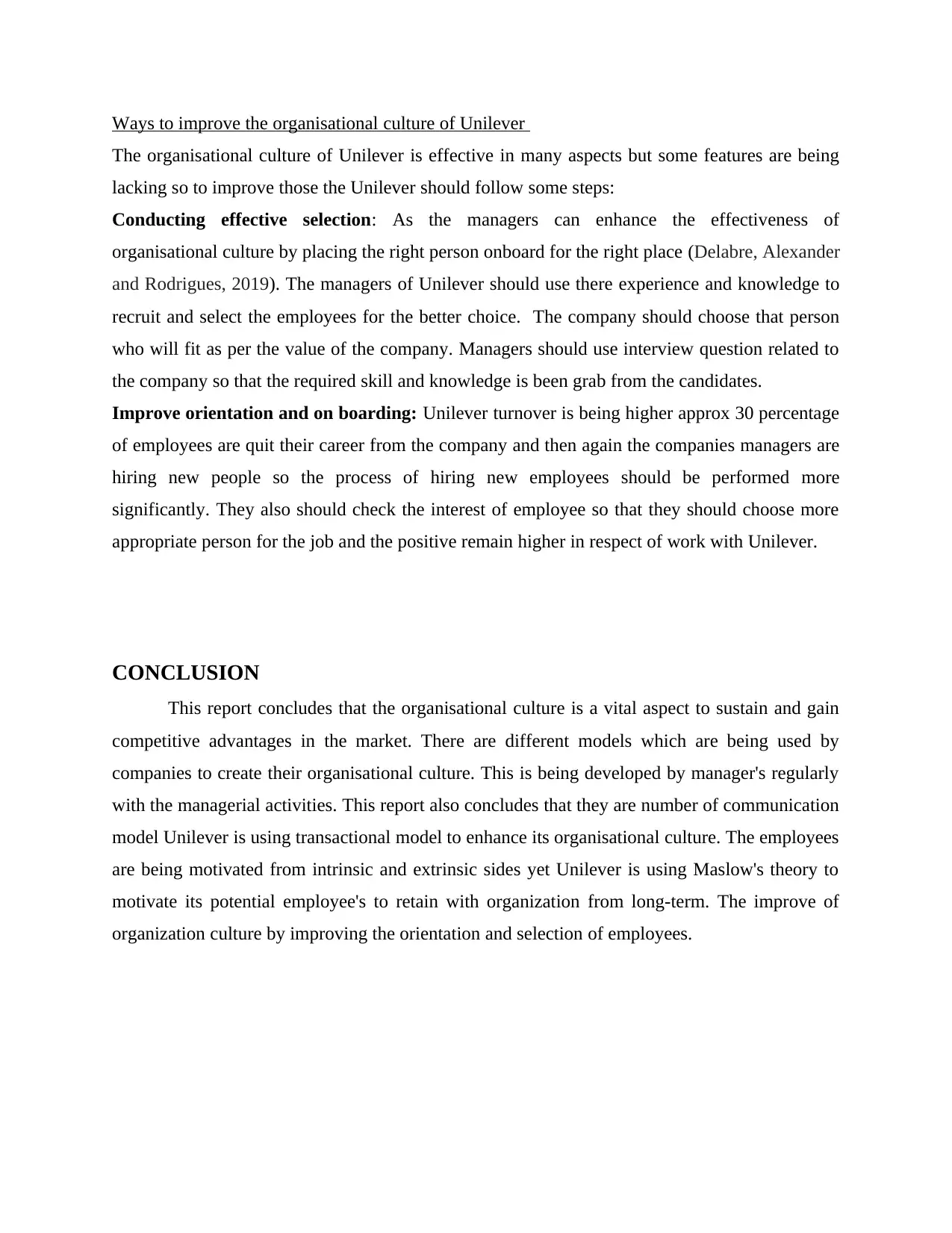
Ways to improve the organisational culture of Unilever
The organisational culture of Unilever is effective in many aspects but some features are being
lacking so to improve those the Unilever should follow some steps:
Conducting effective selection: As the managers can enhance the effectiveness of
organisational culture by placing the right person onboard for the right place (Delabre, Alexander
and Rodrigues, 2019). The managers of Unilever should use there experience and knowledge to
recruit and select the employees for the better choice. The company should choose that person
who will fit as per the value of the company. Managers should use interview question related to
the company so that the required skill and knowledge is been grab from the candidates.
Improve orientation and on boarding: Unilever turnover is being higher approx 30 percentage
of employees are quit their career from the company and then again the companies managers are
hiring new people so the process of hiring new employees should be performed more
significantly. They also should check the interest of employee so that they should choose more
appropriate person for the job and the positive remain higher in respect of work with Unilever.
CONCLUSION
This report concludes that the organisational culture is a vital aspect to sustain and gain
competitive advantages in the market. There are different models which are being used by
companies to create their organisational culture. This is being developed by manager's regularly
with the managerial activities. This report also concludes that they are number of communication
model Unilever is using transactional model to enhance its organisational culture. The employees
are being motivated from intrinsic and extrinsic sides yet Unilever is using Maslow's theory to
motivate its potential employee's to retain with organization from long-term. The improve of
organization culture by improving the orientation and selection of employees.
The organisational culture of Unilever is effective in many aspects but some features are being
lacking so to improve those the Unilever should follow some steps:
Conducting effective selection: As the managers can enhance the effectiveness of
organisational culture by placing the right person onboard for the right place (Delabre, Alexander
and Rodrigues, 2019). The managers of Unilever should use there experience and knowledge to
recruit and select the employees for the better choice. The company should choose that person
who will fit as per the value of the company. Managers should use interview question related to
the company so that the required skill and knowledge is been grab from the candidates.
Improve orientation and on boarding: Unilever turnover is being higher approx 30 percentage
of employees are quit their career from the company and then again the companies managers are
hiring new people so the process of hiring new employees should be performed more
significantly. They also should check the interest of employee so that they should choose more
appropriate person for the job and the positive remain higher in respect of work with Unilever.
CONCLUSION
This report concludes that the organisational culture is a vital aspect to sustain and gain
competitive advantages in the market. There are different models which are being used by
companies to create their organisational culture. This is being developed by manager's regularly
with the managerial activities. This report also concludes that they are number of communication
model Unilever is using transactional model to enhance its organisational culture. The employees
are being motivated from intrinsic and extrinsic sides yet Unilever is using Maslow's theory to
motivate its potential employee's to retain with organization from long-term. The improve of
organization culture by improving the orientation and selection of employees.
⊘ This is a preview!⊘
Do you want full access?
Subscribe today to unlock all pages.

Trusted by 1+ million students worldwide
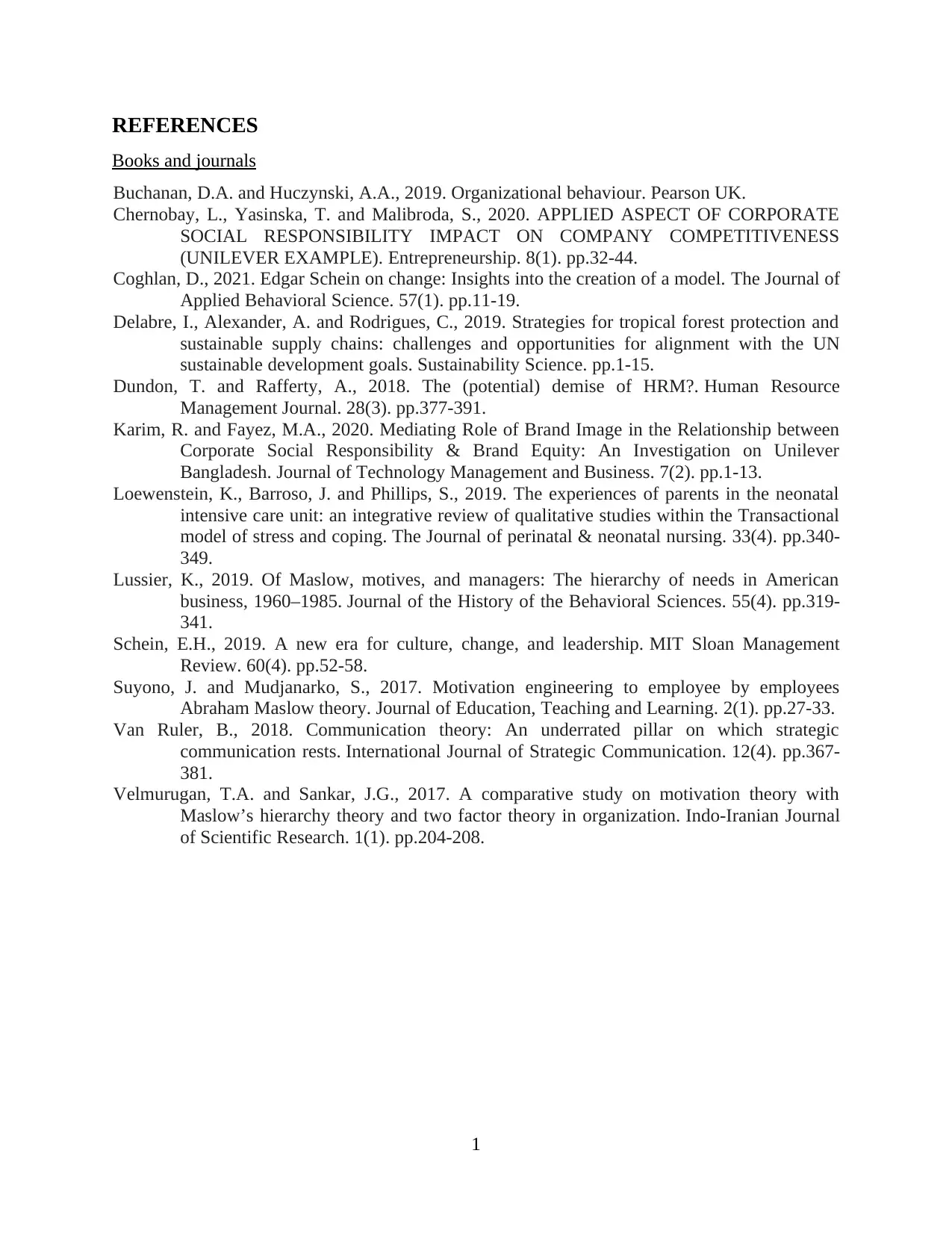
REFERENCES
Books and journals
Buchanan, D.A. and Huczynski, A.A., 2019. Organizational behaviour. Pearson UK.
Chernobay, L., Yasinska, T. and Malibroda, S., 2020. APPLIED ASPECT OF CORPORATE
SOCIAL RESPONSIBILITY IMPACT ON COMPANY COMPETITIVENESS
(UNILEVER EXAMPLE). Entrepreneurship. 8(1). pp.32-44.
Coghlan, D., 2021. Edgar Schein on change: Insights into the creation of a model. The Journal of
Applied Behavioral Science. 57(1). pp.11-19.
Delabre, I., Alexander, A. and Rodrigues, C., 2019. Strategies for tropical forest protection and
sustainable supply chains: challenges and opportunities for alignment with the UN
sustainable development goals. Sustainability Science. pp.1-15.
Dundon, T. and Rafferty, A., 2018. The (potential) demise of HRM?. Human Resource
Management Journal. 28(3). pp.377-391.
Karim, R. and Fayez, M.A., 2020. Mediating Role of Brand Image in the Relationship between
Corporate Social Responsibility & Brand Equity: An Investigation on Unilever
Bangladesh. Journal of Technology Management and Business. 7(2). pp.1-13.
Loewenstein, K., Barroso, J. and Phillips, S., 2019. The experiences of parents in the neonatal
intensive care unit: an integrative review of qualitative studies within the Transactional
model of stress and coping. The Journal of perinatal & neonatal nursing. 33(4). pp.340-
349.
Lussier, K., 2019. Of Maslow, motives, and managers: The hierarchy of needs in American
business, 1960–1985. Journal of the History of the Behavioral Sciences. 55(4). pp.319-
341.
Schein, E.H., 2019. A new era for culture, change, and leadership. MIT Sloan Management
Review. 60(4). pp.52-58.
Suyono, J. and Mudjanarko, S., 2017. Motivation engineering to employee by employees
Abraham Maslow theory. Journal of Education, Teaching and Learning. 2(1). pp.27-33.
Van Ruler, B., 2018. Communication theory: An underrated pillar on which strategic
communication rests. International Journal of Strategic Communication. 12(4). pp.367-
381.
Velmurugan, T.A. and Sankar, J.G., 2017. A comparative study on motivation theory with
Maslow’s hierarchy theory and two factor theory in organization. Indo-Iranian Journal
of Scientific Research. 1(1). pp.204-208.
1
Books and journals
Buchanan, D.A. and Huczynski, A.A., 2019. Organizational behaviour. Pearson UK.
Chernobay, L., Yasinska, T. and Malibroda, S., 2020. APPLIED ASPECT OF CORPORATE
SOCIAL RESPONSIBILITY IMPACT ON COMPANY COMPETITIVENESS
(UNILEVER EXAMPLE). Entrepreneurship. 8(1). pp.32-44.
Coghlan, D., 2021. Edgar Schein on change: Insights into the creation of a model. The Journal of
Applied Behavioral Science. 57(1). pp.11-19.
Delabre, I., Alexander, A. and Rodrigues, C., 2019. Strategies for tropical forest protection and
sustainable supply chains: challenges and opportunities for alignment with the UN
sustainable development goals. Sustainability Science. pp.1-15.
Dundon, T. and Rafferty, A., 2018. The (potential) demise of HRM?. Human Resource
Management Journal. 28(3). pp.377-391.
Karim, R. and Fayez, M.A., 2020. Mediating Role of Brand Image in the Relationship between
Corporate Social Responsibility & Brand Equity: An Investigation on Unilever
Bangladesh. Journal of Technology Management and Business. 7(2). pp.1-13.
Loewenstein, K., Barroso, J. and Phillips, S., 2019. The experiences of parents in the neonatal
intensive care unit: an integrative review of qualitative studies within the Transactional
model of stress and coping. The Journal of perinatal & neonatal nursing. 33(4). pp.340-
349.
Lussier, K., 2019. Of Maslow, motives, and managers: The hierarchy of needs in American
business, 1960–1985. Journal of the History of the Behavioral Sciences. 55(4). pp.319-
341.
Schein, E.H., 2019. A new era for culture, change, and leadership. MIT Sloan Management
Review. 60(4). pp.52-58.
Suyono, J. and Mudjanarko, S., 2017. Motivation engineering to employee by employees
Abraham Maslow theory. Journal of Education, Teaching and Learning. 2(1). pp.27-33.
Van Ruler, B., 2018. Communication theory: An underrated pillar on which strategic
communication rests. International Journal of Strategic Communication. 12(4). pp.367-
381.
Velmurugan, T.A. and Sankar, J.G., 2017. A comparative study on motivation theory with
Maslow’s hierarchy theory and two factor theory in organization. Indo-Iranian Journal
of Scientific Research. 1(1). pp.204-208.
1
Paraphrase This Document
Need a fresh take? Get an instant paraphrase of this document with our AI Paraphraser
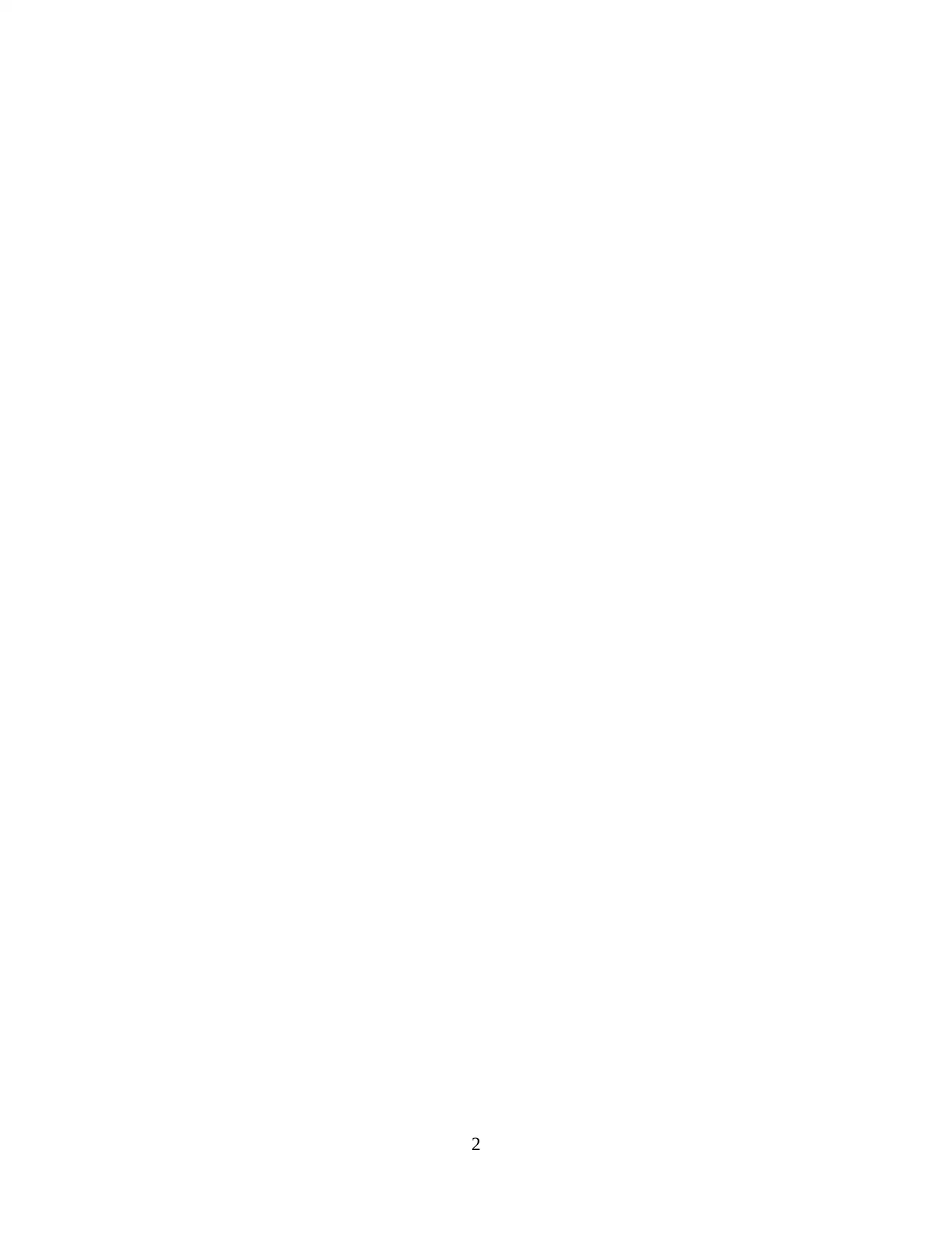
2
1 out of 11
Related Documents
Your All-in-One AI-Powered Toolkit for Academic Success.
+13062052269
info@desklib.com
Available 24*7 on WhatsApp / Email
![[object Object]](/_next/static/media/star-bottom.7253800d.svg)
Unlock your academic potential
Copyright © 2020–2025 A2Z Services. All Rights Reserved. Developed and managed by ZUCOL.




